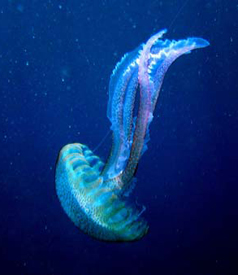Sunday 03 August 2008
by: Elizabeth Rosenthal, The New York Times

Jellyfish floats in the sea off the coast
of Mallorca, Spain. Ecological scientists believe that the influx
of jellyfish is related to climate change. (Photo: Dani Cardona
/ Reuters)
Overfishing, climate change, pollution cited.
Barcelona - Blue patrol boats crisscross the swimming areas of beaches here with their huge nets skimming the water's surface. The yellow flags that urge caution and the red flags that prohibit swimming because of risky currents are sometimes topped now with blue ones warning of a new danger: swarms of jellyfish.
In a period of hours during a day a couple of weeks ago, 300 people on Barcelona's bustling beaches were treated for stings, and 11 were taken to hospitals.
From Spain to New York, to Australia, Japan and Hawaii, jellyfish are becoming more numerous and more widespread, and they are showing up in places where they have rarely been seen before, scientists say. The faceless marauders are stinging children blithely bathing on summer vacations, forcing beaches to close and clogging fishing nets.
But while jellyfish invasions are a nuisance to tourists and a hardship to fishermen, for scientists they are a source of more profound alarm, a signal of the declining health of the world's oceans.
"These jellyfish near shore are a message the sea is sending us saying, 'Look how badly you are treating me,"' said Josep-Marða Gili, a leading jellyfish researcher, who has studied them at the Institute of Marine Sciences of the Spanish National Research Council in Barcelona for more than 20 years.
The explosion of jellyfish populations, scientists say, reflects a combination of severe overfishing of natural predators, like tuna, sharks, and swordfish; rising sea temperatures caused in part by global warming; and pollution that has depleted oxygen levels in coastal shallows.
These problems are pronounced in the Mediterranean, a sea bounded by more than a dozen countries that rely on it for business and pleasure. Left unchecked in the Mediterranean and elsewhere, these problems could make the swarms of jellyfish menacing coastlines a grim vision of seas to come.
"The problem on the beach is a social problem," said Gili, who talks with admiration of the "beauty" of the globular jellyfish. "We need to take care of it for our tourism industry. But the big problem is not on the beach. It's what's happening in the seas."
Jellyfish, relatives of the sea anemone and coral that for the most part are relatively harmless, in fact are the cockroaches of the open waters, the ultimate maritime survivors that thrive in damaged environments, and that is what they are doing.
Within the past year, there have been beach closings because of jellyfish swarms on the Côte d'Azur in France, the Great Barrier Reef of Australia, and at Waikiki and Virginia Beach in the United States.
In Australia, more than 30,000 people were treated for stings last year, double the number in 2005. The rare but deadly Irukandji jellyfish is expanding its range in Australia's warming waters, marine scientists say.
While no good global database exists on jellyfish populations, the increasing reports from around the world have convinced scientists that the trend is serious and climate-related, although they caution that jellyfish populations in any one place vary from year to year.
"Human-caused stresses, including global warming and overfishing, are encouraging jellyfish surpluses in many tourist destinations and productive fisheries," according to the National Science Foundation, which is issuing a report on the phenomenon this fall and lists as problem areas Australia, the Gulf of Mexico, Hawaii, the Black Sea, Namibia, Britain, the Mediterranean, the Sea of Japan, and the Yangtze estuary.
In Barcelona, one of Spain's most vibrant tourist destinations, city officials and the Catalan Water Agency have started fighting back, trying desperately to ensure that it is safe for swimmers to go back in the water.
Each morning, with the help of Gili's team, boats monitor offshore jellyfish swarms, winds and currents to see if beaches are threatened and if closings are needed. They also check if jellyfish collection in the waters near the beaches is needed. Nearly 100 boats stand ready to help in an emergency, said Xavier Duran of the water agency.
The constant squeal of Gili's cellphone reflected his de facto role as Spain's jellyfish control and command center. Calls came from all over.
Officials in Santander and the Basque country were concerned about frequent sightings this year on the Atlantic coast of the Portuguese man-of-war, a sometimes lethal warm-water species not previously seen regularly in those regions.
Farther south, a fishing boat from the Murcia region called to report an offshore swarm of Pelagia noctiluca an iridescent purplish jellyfish that issues a nasty sting more than a mile long. A chef, presumably trying to find some advantage in the declining oceans, wanted to know whether the local species were safe to eat if cooked. Much is unknown about the jellyfish, and Gili was unsure.
In previous decades there were jellyfish problems for only a couple of days every few years; now the threat of jellyfish is a daily headache for local officials and is featured on the evening news. "In the past few years the dynamic has changed completely the temperature is a little warmer," Gili said.
Though the stuff of horror B-movies, jellyfish are hardly aggressors. They float haplessly with the currents. They discharge their venom automatically when they bump into something warm - a human body, for example - from poison-containing stingers on mantles, arms or long, threadlike tendrils, which can grow to be yards long.
Some, like the Portuguese man-of-war or the giant box jellyfish, can be deadly on contact. Pelagia noctiluca, common in the Mediterranean, delivers a painful sting producing a wound that lasts weeks, months or years, depending on the person and the amount of contact.
Comments
I read this kind of article,